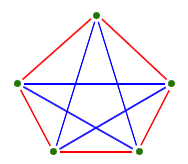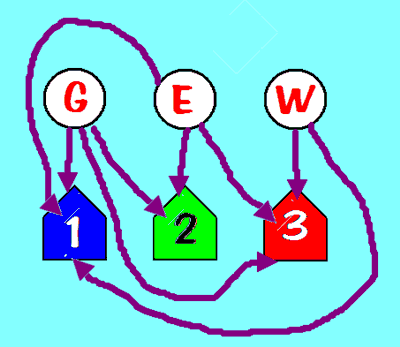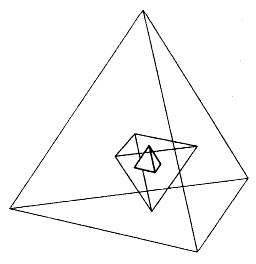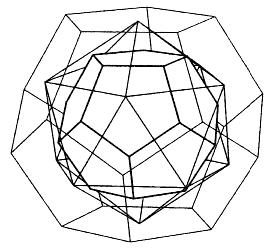- Your quiz this week will be over the symmetry material we studied
in the handout we worked on together in class. You should know your
reflection and rotational symmetries.
- I submitted your midterm grades today:
- I made an assumption that you would complete your two projects well -- so please do.
- I used your first exam grade to predict your grades on your future exams as well. If your grade on that exam was low, hopefully you'll do better going forward!
- I used only one of your two drops for the quizzes (unless you have extra "GOQF" cards, which I applied right away).
- We built the Platonic solids with geomags, and created a table
which described many of their super-symmetric features:
- A Platonic solid is a solid for which
- All faces are congruent (identical) convex regular polygons, and
- Each face, each edge, and each vertex is exactly equivalent to every other face, edge, or vertex (respectively).
They're super-symmetric!
The Five Convex Regular Polyhedra (Platonic solids) -- thanks Wikipedia! Tetrahedron Hexahedron
or CubeOctahedron Icosahedron Dodecahedron 




fire earth air water universe - The summary table, illustrating the duality between pairs of the solids (the tetrahedron is paired with itself!):
Solid name # of Vertices Edges Faces faces at each vertex edges at each face Tetrahedron 4 6 4 3 3 Cube 8 12 6 3 4 Octahedron 6 12 8 4 3 Dodecahedron 20 30 12 3 5 Icosahedron 12 30 20 5 3 What conclusions can we draw from this data? Is there a pattern? (Of course there is!:) The pattern leads to the concept of "Duality":
Each Platonic solid has a "twin" -- called its dual -- which we can discover from the table.
"In the Hindu tradition, the icosahedron represents purusha, the male, spiritual principle, and generates the dodecahedron, representing prakriti, the female, material principle."
- A Platonic solid is a solid for which
- How might we draw the Platonic solids on a sheet of paper? We
project them onto the paper:
- The cube you've undoubtedly done before.
- The tetrahedron can be drawn as a Mercedes Benz symbol

- Here
are all the solids, projected onto paper (from three
dimensions down to two dimensions). Practice
drawing them!
It turns out that they can all be drawn without any edges intersecting each other. This is one of the important concepts we want to talk about today.
- Graph Theory started with an interesting problem:
- The Bridges
of Konigsberg problem: "is it possible to set off and walk around Konigsberg crossing each bridge exactly once?"
What do you think?


- This problem, solved by Leonhard
Euler (1735), was the beginning of graph theory.
As a reminder, we'll review some of the definitions of graphs we've seen to this point, as well as get some new definitions.
- Graphs are made up of vertices (points) and edges
that connect the vertices. More formally, a
graph is defined as
- A collection of points, called vertices.
- A collection of edges, each of which connects two vertices (if the same vertex is used twice, the edge is called a loop).
- a rule telling how each edge is connected to a pair of vertices.
- A graph is simple if it doesn't have any
loops (edges connected from a vertix to
itself), or multiple edges connecting the same
two vertices.
- Complete graphs are simple graphs with single edges between every pair of vertices (but no loops).
- A graph is connected if there is a path (a
means of moving from one vertex to another
along edges) from each vertex to every other
vertex.
- The degree of a vertex is the number of edges coming into it.
- Graphs are made up of vertices (points) and edges
that connect the vertices. More formally, a
graph is defined as
- Euler's solution:
- Extract out only the important information into a graph (which, to that point, hadn't been invented!).
- Konigsberg: To be traversable (i.e. have an "Euler path"), there must be at most two vertices of odd degree.
- Euler noticed the hand-shaking theorem: in any graph, the number of vertices with odd degree must be even.
- An alternative solution.
- "Floor plans" of houses either have an Euler path, or they don't. The rooms are like land masses, and the doors are like bridges. Let's try one!
- This problem, solved by Leonhard
Euler (1735), was the beginning of graph theory.
- Graphs don't change by bending edges, but breaking them or
detaching edges from their vertices (and hence creating new vertices)
gives new graphs.
- Exercises: on simple graphs
- Draw all the distinctly different simple graphs with three
vertices.
- A cycle is a route from a node back to itself that doesn't retrace steps.
- One of these graphs is a (non-rooted) tree: a
connected graph that has no cycles.
- Where have we seen trees used before?:)
- Duality -- again!
- Draw all the distinctly different simple graphs
with four vertices.
- Have you ever seen any of these before? Could we give any of them names?
- Sometimes it's hard to tell if two graphs are actually the same... We say "isomorphic".
- Can you draw them in a way that emphasizes symmetry?
- Can you draw them in a way that emphasizes duality?
- Draw all the distinctly different simple graphs with three
vertices.
- Planar graphs are graphs that can be drawn such that no two edges
intersect.
- Every Platonic
graph can be drawn this way, so they are planar graphs.
- As a "homework" (for your own good!), I have asked you to
cut out and create Platonic solids from paper, using
this template.
Let's inspect these drawings, and see why these five configurations of polygons work: while two of these polygons can tile the plane (the square and the triangle), we throw out enough neighbors of each of the polygons so that there's room to fold up the cut-outs.
The pentagon won't tile the plane -- there must be space between some pentagons. Any polygon with more than five sides will be "too cramped" to fold up....
Note: these are not graphs of the Platonic solids, because many of the "edges" are redundant, and there are too many vertices.
- Euler also discovered a formula for planar graphs:
\[
F-E+V=2
\]
where F is the number of faces, E the number of edges,
and V the number of vertices.
If we check our table for the Platonic solids, we'll see that they all hold up.
It turns out that it also works for soccer balls, and other polyhedra. The countries on a globe, for example. Actually anything that can be projected onto planar graph!
Euler's formula is also what's wrong with six-sided polyhedra (and beyond).
The argument against six-sided polyhedra involves Euler's formula, as Weyl discusses.
- Which of the Platonic solid graphs can be traversed without backtracking?
- Every Platonic
graph can be drawn this way, so they are planar graphs.
- Exercises:
- We can show that the complete graph with four vertices is planar.
- Let's see if we can show that the complete graph
with five vertices is not planar:

Why not? What goes wrong?
- The three utilities and three houses graph is not planar:

- Any non-planar graph has a copy of one of these two graphs
in it somewhere, as a subgraph:

- The Bridges
of Konigsberg problem: "is it possible to set off and walk around Konigsberg crossing each bridge exactly once?"
- Symmetry, by Hermann Weyl (Princeton University Press, 1952)
- Symmetry of lifeforms on Earth
- A fun reading on symmetry
- Meet the world's Mrs Averages: Scientists blend thousands of faces together to reveal what the typical woman's face looks like in 41 different countries from around the globe
- Comparing
theory--driven and data-driven attractiveness models using images of
real women's faces
This paper contains a lot of references, and on-line resources to document their work.
- The Brain's
Face Recognition System Is Easy to Fool:
The human brain is good at identifying faces, but illusions can fool our "face sense"
"Because the human brain is so good at detecting faces, we sometimes see them where they do not exist. Were you ever scared as a child by strange faces popping up from an abstract wallpaper design or formed by shadows in the semidarkness of your bedroom? Ever notice that cars seem to have faces, with the headlights as eyes and the grilles as mouths? These effects result from the face-recognition circuits of our brains, which are constantly trying to find a face in the crowd."
- Modeling individual preferences reveals that face beauty is not universally perceived across cultures
- Symmetry, by Hermann Weyl (Princeton University Press, 1952)
- Symmetry of lifeforms on Earth
- A fun reading on symmetry
- Hexagonal Paper


